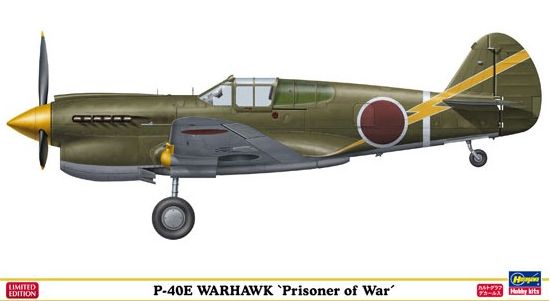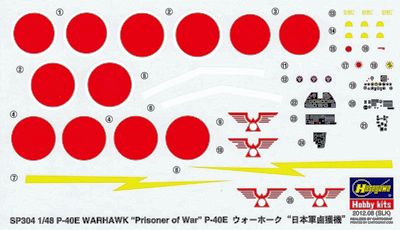
| KIT #: | 52104 |
| PRICE: | $22.95 on sale ($50.00 SRP) |
| DECALS: | Three options plus |
| REVIEWER: | Scott Van Aken |
| NOTES: | 2012 boxing |

| HISTORY |
The P-40E or P-40E-1 was similar in most respects to the P-40D, except for a slightly more powerful engine and an extra .50 in (12.7 mm) gun in each wing, bringing the total to six. Some aircraft also had small underwing bomb shackles. Supplied to the Commonwealth air forces as the Kittyhawk Mk IA. The P-40E was the variant that bore the brunt of air-to-air combat by the type in the key period of early to mid 1942, for example with the first US squadrons to replace the AVG in China (the AVG was already transitioning to this type from the P-40B/C), the type used by the Australians at Milne Bay, by the New Zealand squadrons during most of their air to air combat, and by the RAF/Commonwealth in North Africa as the Kittyhawk IA.
The Japanese Army captured some P-40s and later operated a number in Burma. The Japanese appear to have had as many as 10 flyable P-40Es. For a brief period in 1943, a few of them were actually used operationally by 2 Hiko Chutai, 50 Hiko Sentai (2nd Air Squadron, 50th Air Regiment) in the defense of Rangoon. Testimony of this is given by Yasuhiko Kuroe, a member of the 64 Hiko Sentai. In his memoirs, he says one Japanese-operated P-40 was shot down in error by a friendly Mitsubishi Ki-21 "Sally" over Rangoon.
| THE KIT |
 The
kit has more inserts than a Sunday newspaper. There are separate sprues for the tail, the gun
inserts, the ejector chute inserts, the windscreen, canopy and backlight.
Same goes for the exhaust and prop and instrument panel. There are options
for clear wing tip lights (you have to cut off the old ones) a gun camera,
drop tank and bomb. Two styles of wheels are provided, both spoked and
covered, though I suppose the spoked versions are for later kits. Unlike other P-40E kits, the braces for the bomb and
the drop tank are different to take into consideration the different
shapes. The cowl flaps are also molded in the open position. The prop looks
like the tips may be a bit more rounded than I'm used to seeing in P-40
kits, but may well be more accurate.
The
kit has more inserts than a Sunday newspaper. There are separate sprues for the tail, the gun
inserts, the ejector chute inserts, the windscreen, canopy and backlight.
Same goes for the exhaust and prop and instrument panel. There are options
for clear wing tip lights (you have to cut off the old ones) a gun camera,
drop tank and bomb. Two styles of wheels are provided, both spoked and
covered, though I suppose the spoked versions are for later kits. Unlike other P-40E kits, the braces for the bomb and
the drop tank are different to take into consideration the different
shapes. The cowl flaps are also molded in the open position. The prop looks
like the tips may be a bit more rounded than I'm used to seeing in P-40
kits, but may well be more accurate.
In terms of glitches, there were not many. There are tiny ejector pin marks in the separate wheel wells and my seat frame had been broken in half by all the sprues banging around in the bag. I also found some sink areas under the wing and the ejector pin holes are so deep on the inside of the wing that there are impressions of them on the outside. They will probably disappear under paint. I do like having the gun barrels already drilled out and wish they could have done the same with the exhaust stubs. I also found ejector pin marks on the wheels and the landing gear.
What isn't offered are separate flaps, and this is just fine as the vast majority of P-40 photos you see have these raised when parked. Other inserts are for the cooling vents (or lack of in the forward nose, the carb intake, and you'll have to plug a few holes, drill a few holes, and trim a part or two during the construction.
The interior is pretty nicely detailed, though not really to the same standard as their Japanese fighters such as the Ki-84 and Ki-43. However, it is more than adequate for most of us. From what I can see, the seat and instrument panel are appropriate for this aircraft. The P-40 is not that complex an aircraft, even with all the inserts so it should build well.
Markings on this one are for three captured planes.
These were undoubtedly those that were left in crates during the hasty retreat
from the Dutch East Indies as well as others left on airfields after having been
over run by advancing Japanese troops. All are in OD over Neutral Grey. T he
box art plane is one used by the 50th Sentai in Rangoon during March 1943. Next,
with the bird decals on the fin is one that was tested in Java during 1942. The
third has a white spinner, elevators, and rudder with just insignia and a
fuselage band when with the 25th Sentai in China during 1943. Decals are
nicely printed and include two styles of decals for the instrument panel; one
with a black background and one that is just the instrument faces. Also included
in this box is a decal sheet from the 'Aleutian Tiger' boxing that provides
three different aircraft options. A photo copied set of markings instructions
for these planes is also included. A nice touch.
he
box art plane is one used by the 50th Sentai in Rangoon during March 1943. Next,
with the bird decals on the fin is one that was tested in Java during 1942. The
third has a white spinner, elevators, and rudder with just insignia and a
fuselage band when with the 25th Sentai in China during 1943. Decals are
nicely printed and include two styles of decals for the instrument panel; one
with a black background and one that is just the instrument faces. Also included
in this box is a decal sheet from the 'Aleutian Tiger' boxing that provides
three different aircraft options. A photo copied set of markings instructions
for these planes is also included. A nice touch.
| CONCLUSIONS |
Hasegawa seems to have the 1/48 later P-40 market pretty well locked up if you are a fan of the type. Their kit are a bit fiddly thanks to all the inserts, but careful building will reduce the amount of filler needed and you'll get a very nice model right from the box. Those who can't stand to build anything stock will find all the aftermarket bits you want for this one.
| REFERENCES |
http://en.wikipedia.org/wiki/P-40_Warhawk
April 2014 Thanks to me for the preview kit.
If you would like your product reviewed fairly and fairly quickly, please
contact the editor
or see other details in the
Note to
Contributors.